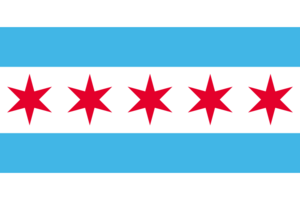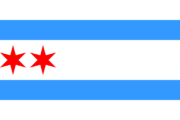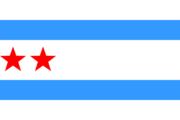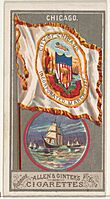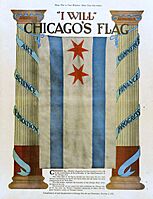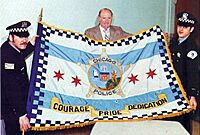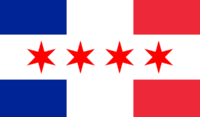Flag of Chicago facts for kids
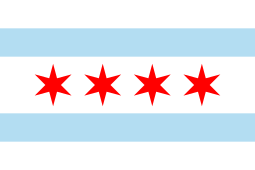 |
|
| Use | Civil flag |
|---|---|
| Proportion | 2:3 |
| Adopted | Original, 1917; additional stars added, 1933 and 1939. |
| Design | Argent four mullets of six points gules in fess between two bars bleu de ciel. |
| Designed by | Wallace Rice |
The flag of Chicago is a cool symbol of the city! It has two light blue stripes on a white background. In the middle, there are four bright red stars, each with six points. These stripes and stars all have special meanings that tell the story of Chicago.
Contents
What the Flag Means
The Chicago flag isn't just pretty; every part tells a story about the city!
The Stripes and Background
The flag has three white areas and two blue stripes.
- The top white part stands for the North Side of Chicago.
- The middle white part represents the West Side.
- The bottom white part symbolizes the South Side.
The two blue stripes are also important:
- The top blue stripe shows Lake Michigan and the North Branch of the Chicago River.
- The bottom blue stripe represents the South Branch of the river. It also stands for the "Great Canal" (the Chicago Sanitary and Ship Canal). This canal was built over the Chicago Portage, a historic water route.
- The light blue color is often called "sky blue" or "pale blue." The flag's designer, Wallace Rice, once said it was "the color of water."
The Stars on the Flag
There are four red stars in the middle white stripe. Each star has six points. Six-pointed stars were chosen because five-pointed stars usually represent countries. Also, this design was unique when the flag was created in 1917.
Let's look at what each star means, starting from the left side of the flag:
- First Star (added in 1939): This star remembers Fort Dearborn. This fort was an important early settlement in Chicago. Its six points show the different governments that ruled the Chicago area over time:
- France (from 1693)
- Great Britain (from 1763)
- Virginia (from 1778)
- The Northwest Territory (from 1789)
- Indiana Territory (from 1802)
- Illinois (as a territory from 1809, and a state since 1818)
- Second Star (original to 1917 flag): This star represents the Great Chicago Fire of 1871. This was a huge fire that destroyed much of the city. Its six points stand for important qualities: religion, education, art, justice, kindness, and city pride.
- Third Star (original to 1917 flag): This star symbolizes the World's Columbian Exposition of 1893. This was a very famous world's fair held in Chicago. Its six points represent: transportation, work, business, money, population, and health.
- Fourth Star (added in 1933): This star stands for the Century of Progress Exposition. This was another world's fair held in Chicago from 1933 to 1934. Its points refer to:
- Chicago being the second-largest city in the U.S. at that time.
- Chicago's Latin motto, Urbs in horto (which means "City in a garden").
- Chicago's "I Will" motto.
- The city being a "Great Central Marketplace."
- Chicago being a "Wonder City."
- Chicago being a "Convention City."
Ideas for a Fifth Star
Many people have suggested adding a fifth star to the flag. Here are some of the ideas:
- Some thought a star could honor Chicago's role in the nuclear age. This idea came up in the 1940s.
- In the 1980s, a star was suggested for Harold Washington. He was Chicago's first African-American mayor.
- The 1992 Chicago Flood was another idea. Some felt it deserved a star, like the Great Chicago Fire.
- When Chicago tried to host the 2016 Summer Olympics, a fifth star was proposed. It would have celebrated the city hosting the games. However, Rio de Janeiro won the bid instead.
- Others have suggested a star for the Special Olympics. This event was founded in Chicago.
- Sports fans have also had ideas! Some wanted a star for the Chicago Bulls' success in the 1990s. Another idea was for a star if the Chicago Cubs won the World Series. They finally won in 2016 after a very long time!
- The Chicago History Museum even has an exhibit. People can vote there for what a fifth star could represent.
- Chicago Mayor Lori Lightfoot suggested a star for the city's response to the COVID-19 pandemic.
History of the Flag
Chicago Tribune Contest
The idea for a city flag became popular before the Chicago World's Fair. In 1892, the Chicago Tribune newspaper held a contest. They offered $100 for the best city colors or design.
A Danish architect named Alfred Råvad won the contest. He had just moved to Chicago to design buildings for the World's Fair. Råvad suggested red and white as the city's colors. His design also included a horizontal "Y" shape. This "Y" represented the Chicago River and its branches. Råvad's design was used unofficially for a while. However, it was never officially approved as the city flag.
Wallace Rice's Design
In 1915, Mayor William Hale Thompson created a special flag committee. This committee included important people like industrialist Charles Deering. They asked a poet and lecturer named Wallace Rice to help. Rice created the rules for a public competition to design the best flag. Over a thousand designs were sent in!
Wallace Rice's design won the competition. The Chicago City Council officially adopted it in 1917. When it was first adopted, the flag only had two stars. A third star was added in 1933. The current four-star version has been used since 1939.
The flag's design is very meaningful. The white sections and blue stripes show Chicago's geography. The stars represent important historical events. The points on the stars stand for important ideas or virtues. The historical events are:
- The building of Fort Dearborn.
- The Great Chicago Fire of 1871.
- The World's Columbian Exposition of 1893.
- The Century of Progress Exposition of 1933–34.
In 1928, Mayor William Hale Thompson wanted to change the stars. He thought they should be five-pointed instead of six-pointed. He felt five-pointed stars were more "American." The City Council agreed, but the change was never officially written into the city's laws. When the third star was added in 1933, the Council confirmed that the stars should stay six-pointed.
The Chicago flag is very well-liked. In 2004, the North American Vexillological Association reviewed 150 American city flags. Chicago's flag was ranked second-best, with a score of 9.03 out of 10! Only the flag of Washington, D.C. scored higher.
Gallery
-
Kitty Kelly holding Flag of Chicago from the Chicago Tribune, 1921. Note the two stars on the flag at the time.
-
Unveiling of the flag of the Chicago Police Department, c. 1977
See also
 In Spanish: Bandera de Chicago para niños
In Spanish: Bandera de Chicago para niños



